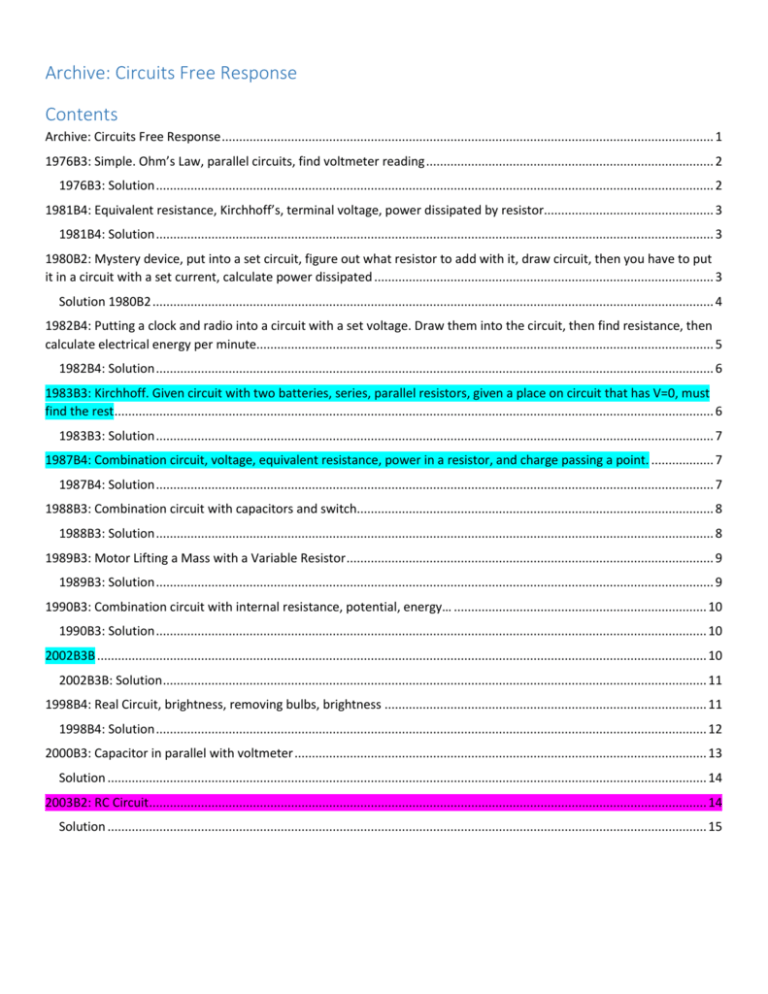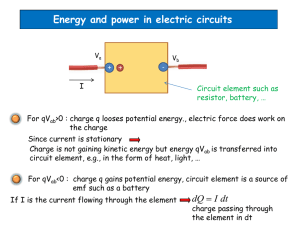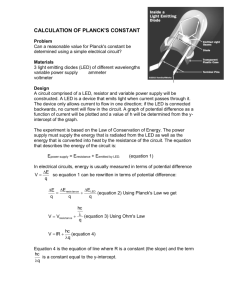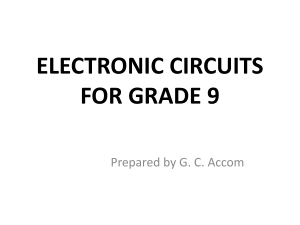1981B4: Solution
advertisement

Archive: Circuits Free Response Contents Archive: Circuits Free Response .............................................................................................................................................. 1 1976B3: Simple. Ohm’s Law, parallel circuits, find voltmeter reading ................................................................................... 2 1976B3: Solution ................................................................................................................................................................. 2 1981B4: Equivalent resistance, Kirchhoff’s, terminal voltage, power dissipated by resistor................................................. 3 1981B4: Solution ................................................................................................................................................................. 3 1980B2: Mystery device, put into a set circuit, figure out what resistor to add with it, draw circuit, then you have to put it in a circuit with a set current, calculate power dissipated .................................................................................................. 3 Solution 1980B2 .................................................................................................................................................................. 4 1982B4: Putting a clock and radio into a circuit with a set voltage. Draw them into the circuit, then find resistance, then calculate electrical energy per minute.................................................................................................................................... 5 1982B4: Solution ................................................................................................................................................................. 6 1983B3: Kirchhoff. Given circuit with two batteries, series, parallel resistors, given a place on circuit that has V=0, must find the rest ............................................................................................................................................................................. 6 1983B3: Solution ................................................................................................................................................................. 7 1987B4: Combination circuit, voltage, equivalent resistance, power in a resistor, and charge passing a point. .................. 7 1987B4: Solution ................................................................................................................................................................. 7 1988B3: Combination circuit with capacitors and switch....................................................................................................... 8 1988B3: Solution ................................................................................................................................................................. 8 1989B3: Motor Lifting a Mass with a Variable Resistor .......................................................................................................... 9 1989B3: Solution ................................................................................................................................................................. 9 1990B3: Combination circuit with internal resistance, potential, energy… ......................................................................... 10 1990B3: Solution ............................................................................................................................................................... 10 2002B3B ................................................................................................................................................................................ 10 2002B3B: Solution ............................................................................................................................................................. 11 1998B4: Real Circuit, brightness, removing bulbs, brightness ............................................................................................. 11 1998B4: Solution ............................................................................................................................................................... 12 2000B3: Capacitor in parallel with voltmeter ....................................................................................................................... 13 Solution ............................................................................................................................................................................. 14 2003B2: RC Circuit................................................................................................................................................................. 14 Solution ............................................................................................................................................................................. 15 1976B3: Simple. Ohm’s Law, parallel circuits, find voltmeter reading 1976B3. In the circuit shown above, the current delivered by the 9-volt battery of internal resistance 1 ohm is 3 amperes. The power dissipated in R2 a. Determine the reading of voltmeter V in the diagram. is 12 watts. b. Determine the resistance of R2 c. Determine the resistance of R. 1976B3: Solution 1981B4: Equivalent resistance, Kirchhoff’s, terminal voltage, power dissipated by resistor 1981B4: Solution 1980B2: Mystery device, put into a set circuit, figure out what resistor to add with it, draw circuit, then you have to put it in a circuit with a set current, calculate power dissipated 1980B2. The electrical device whose symbol is shown above requires a terminal voltage of 12 volts and a current of 2 amperes for proper operation. a. Using only this device and one or more 3-ohm resistors design a circuit so that the device will operate properly when the circuit is connected across a battery of emf 24 volts and negligible internal resistance. Within the dashed-line box in the diagram below, draw the circuit using the symbol for the device and the appropriate symbol for each 3-ohm resistor. b. Using only this device and one or more 3-ohm resistors, design a circuit so that the device will operate properly when connected to a source that supplies a fixed current of 6 amperes. Within the dashed-line box in the diagram below, draw the circuit using the symbol for the device and the appropriate symbol c. Calculate the power dissipation In each 3-ohm resistor used in the circuit in part b. Solution 1980B2 The resistance of the device is found from R = V/I = 6 Ω. With a 24 volt source, to provide a current of 2 A requires a total resistance of 12 Ω. For the additional 6 Ω resistance, place two 3 Ω resistors in series with the device. b. Since the device requires 2 A, a resistor in parallel with the device must carry a current of 6 A – 2 A = 4 A. In parallel with the device, the resistor will have a potential difference of 12 V so must have a resistance of V/I = 3 Ω. Thus, a single 3 Ω resistor in parallel will suffice. c. P = I2R = 48 W 1982B4: Putting a clock and radio into a circuit with a set voltage. Draw them into the circuit, then find resistance, then calculate electrical energy per minute 1982B4. A cabin contains only two small electrical appliances: a radio that requires 10 milliamperes of current at 9 volts, and a clock that requires 20 milliamperes at 15 volts. A 15-volt battery with negligible internal resistance supplies the electrical energy to operate the radio and the clock. a. Complete the diagram below to show how the radio, the clock, and a single resistor R can be connected between points A and B so that the correct potential difference is applied across each appliance. Use the symbols in the diagram above to indicate the radio and the clock. b. Calculate the resistance of R. c. Calculate the electrical energy that must be supplied by the battery to operate the circuits for 1 minute. 1982B4: Solution 1983B3: Kirchhoff. Given circuit with two batteries, series, parallel resistors, given a place on circuit that has V=0, must find the rest 1983B3. The circuit shown above is constructed with two batteries and three resistors. The connecting wires may be considered to have negligible resistance. The current I is 2 amperes. a. Calculate the resistance R. b. Calculate the current in the i. 6-ohm resistor ii. 12-ohm resistor c. The potential at point X is 0 volts. Calculate the electric potential at points B. C, and D in the circuit. d. Calculate the power supplied by the 20-volt battery. 1983B3: Solution 1987B4: Combination circuit, voltage, equivalent resistance, power in a resistor, and charge passing a point. 1987B4: Solution 1988B3: Combination circuit with capacitors and switch 1988B3: Solution 1989B3: Motor Lifting a Mass with a Variable Resistor 1989B3. A series circuit consists of a battery of negligible internal resistance, a variable resistor, and an electric motor of negligible resistance. The current in the circuit is 2 amperes when the resistance in the circuit is adjusted to 10 ohms. Under these conditions the motor lifts a l-kilogram mass vertically at a constant speed of 2 meters per second. 1989B3: Solution 1990B3: Combination circuit with internal resistance, potential, energy… 1990B3. A battery with an emf of 24 volts and an internal resistance of 1 ohm is connected to an external circuit as shown above. Determine each of the following: a. the equivalent resistance of the combination of the 4-ohm, 8-ohm, and 12-ohm resistors b. the current in the 5-ohm resistor c. the terminal voltage, VAC d. the rate at which energy is dissipated in the 12-ohm resistor of the battery e. the magnitude of the potential difference V f. the power delivered by the battery to the external circuit 1990B3: Solution 2002B3B 2002B3B. Lightbulbs of fixed resistance 3.0 Ω and 6.0 Ω, a 9.0 V battery, and a switch S are connected as shown in the schematic diagram above. The switch S is closed. a. Calculate the current in bulb A. b. Which lightbulb is brightest? Justify your answer. c. Switch S is then opened. By checking the appropriate spaces below, indicate whether the brightness of each lightbulb increases, decreases, or remains the same. Explain your reasoning for each lightbulb. i. Bulb A: The brightness increases decreases remains the same Explanation: ii. Bulb B: The brightness increases decreases remains the same Explanation: iii. Bulb C: The brightness increases decreases remains the same Explanation: 2002B3B: Solution 1998B4: Real Circuit, brightness, removing bulbs, brightness 1998B4 In the circuit shown above, A, B, C, and D are identical lightbulbs. Assume that the battery maintains a constant potential difference between its terminals (i.e., the internal resistance of the battery is assumed to be negligible) and the resistance of each lightbulb remains constant. a. Draw a diagram of the circuit in the box below, using the following symbols to represent the components in your diagram. Label the resistors A, B. C, and D to refer to the corresponding lightbulbs. b. List the bulbs in order of their brightnesses, from brightest to least bright. If any two or more bulbs have the same brightness, state which ones. Justify your answer. c. Bulb D is then removed from its socket. i. Describe the change in the brightness, if any, of bulb A when bulb D is removed from its socket. Justify your answer. ii. Describe the change in the brightness, if any, of bulb B when bulb D is removed from its socket. Justify your answer. 1998B4: Solution 2000B3: Capacitor in parallel with voltmeter Solution 2003B2: RC Circuit 2003B2 A circuit contains two resistors (10 Ω and 20 Ω) and two capacitors (12 μF and 6 μF) connected to a 6 V battery, as shown in the diagram above. The circuit has been connected for a long time. a. Calculate the total capacitance of the circuit. b. Calculate the current in the 10 Ω resistor. c. Calculate the potential difference between points A and B. d. Calculate the charge stored on one plate of the 6 μF capacitor. e. The wire is cut at point P. Will the potential difference between points A and B increase, decrease, or remain the same? _____increase _____decrease _____remain the same Justify your answer. Solution









